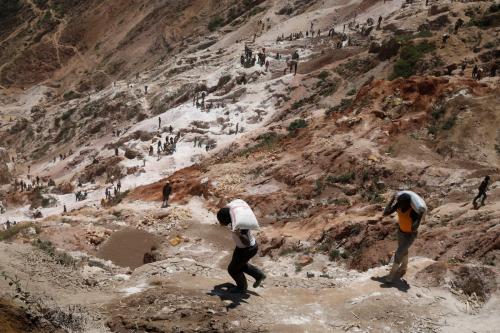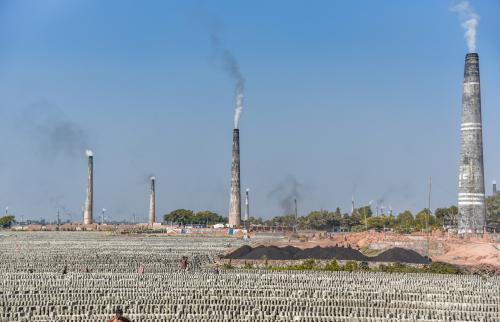The United Nations High Commissioner for Refugees, the Brookings-LSE Project on Internal Displacement and Georgetown University’s Institute for the Study of International Migration organized an expert consultation on Planned Relocation, Disasters and Climate Change: Consolidating Good Practices and Preparing for the Future in Sanremo, Italy, from March 12-14, 2014. The main themes and findings from the consultations are synthesized in this executive summary.
As more and more people live in locations highly vulnerable to disasters and other climate change impacts, planned relocation will be one response States may take to protect affected communities. It is important for States and practitioners to draw lessons from past experiences to ensure that future movements are initiated, planned, and carried out in a rights-respecting manner and lead to the most positive outcomes possible for those involved.
Generating a common understanding of the meaning and content of ‘planned relocation’, along with other related terms, is essential to ensure policy approaches are developed consistently and appropriately, and subsequent actions are based on shared assumptions.
Planned relocation should be considered as a last resort. All reasonable in situ alternatives and solutions should be explored first, unless communities themselves have identified planned relocation as their preferred option.
Well planned relocation can be both a form of disaster risk reduction and a form of climate change adaptation. Planned relocation can be undertaken preemptively (e.g. before a disaster strikes, or as a measure to avoid the longer-term impacts of climate change) or remedially (e.g. following a disaster). Planned relocation may be used as a strategy to avoid future displacement: for example when areas are highly disaster-prone or too dangerous for human habitation, when the impacts of climate change are expected to make life unsustainable in particular areas, or when return to original habitats is not possible.
Most planned relocation is expected to occur within national borders. The effective use of planned relocation within States can serve as a way to avoid situations where people have no other option but to flee across international borders. Where people have crossed international borders and their places of origin have become uninhabitable, impeding their return, planned relocation to other parts of their home State (or, in exceptional circumstances, to other States) may also be a durable solution.
Planned relocation within the borders of a State is primarily the concern of individual States. It will largely be governed by domestic laws, implemented through national structures, and pertain to a range of national frameworks including disaster risk management, climate change adaptation, and development. These domestic laws and practices must comply with applicable international law. Under international law, States bear the primary responsibility to ensure that the human rights of those within their territory or jurisdiction are respected, protected, and fulfilled. This includes the obligation to take preventative as well as remedial action to uphold such rights and to assist and protect those whose rights have been violated. Under international human rights law, the State’s obligation to take preventative measures to safeguard life, physical integrity, and health may sometimes mean that people need to be moved out of harm’s way. In addition to laws, political will and domestic capacity will be crucial to any response.
An assortment of actors—including other States, funders, coordinating bodies, international organizations, regional bodies, humanitarian, and development communities, academic experts and civil society— and multilateral processes have a supporting role in the context of planned relocation made necessary by disasters and other impacts of climate change. Supporting roles may take multiple forms, including formulation of standards, guidance, and operational tools; providing technical assistance and advice; capacity building; generating funding options; developing benchmarks; and undertaking monitoring and evaluation.
There is a need for cross-pollination of expertise, ideas, and action among a variety of experts and institutions, including development, humanitarian assistance, human rights, disaster risk management, environment and climate change, and urban and regional planning, as well as affected governments and communities, as all may be involved in planning and undertaking relocation.
While principles pertinent to planned relocation are found in a wide range of existing guidelines and practice, a document(s) synthesizing and explaining the applicable principles at the various phases of the relocation process may assist States and actors supporting them to undertake relocation in a manner that upholds the humanity, dignity and human rights of affected populations.
Especially needed are practical tools—‘how to’ and technical guides—and action plans to assist national and local authorities and actors supporting them to implement guidance on undertaking planned relocation.
The development of a reference document(s) and ‘how to’ tools and action plans should be informed by: (a) lessons, experience, and guidance from development-induced displacement and resettlement, disaster risk management, and other relevant contexts; and (b) existing guidance directly on, or pertinent to, planned relocation, including the World Bank Guidelines on Involuntary Resettlement, the Nansen Principles on Climate Change and Displacement, the United Nations Guiding Principles on Internal Displacement, the African Union Convention for the Protection and Assistance of Internally Displaced Persons in Africa, the Peninsula Principles on Climate Displacement within States, the Inter-Agency Standing Committee Framework on Durable Solutions for Internally Displaced Persons, IASC Operational Guidelines on the Protection of Persons in Situations of Disasters, the Food and Agriculture Organization in Emergencies Guidance Note on Supporting Displaced People and Durable Solutions, and International Labour Organization Guidelines on the Resettlement of Indigenous Populations. The set of preliminary understandings prepared by Elizabeth Ferris also provides useful guidance. Lessons, experience, and existing guidance could usefully be extrapolated to planned relocation in the context of disasters and climate change.
Guidance and practical tools for States and supporting actors should consider and address the following issues and themes, each of which is elaborated in more depth in the body of this report. In addition to guidance and practical tools, a longer-term strategic plan to better prepare for, institutionalize and implement planned relocation may go some way toward minimizing the negative outcomes that have arisen from relocations in other contexts.



